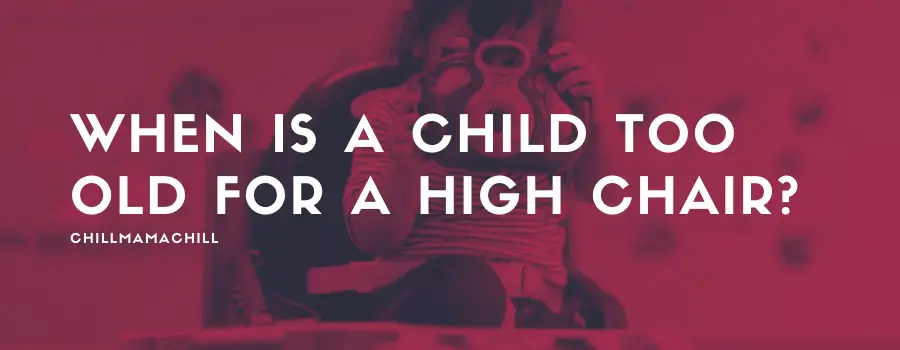You may be eager for when your baby will transition from their feeding perch to a booster seat at the table. While this will signal a leap in their social development, it’s essential to time this shifting right. So, when is a child too old for a high chair, and what milestones should you look out for?
The general rule of thumb is around two years, but not all babies are the same. If your child has developmental issues such as mental in-acuity, they’ll require further strapping-in while feeding. However, you can typically transition your tot to a booster seat between 18 and 24 months if all the telltale signs are there.
Your baby has been sitting on a high chair during mealtimes from four to six months old. It’s important to tell when it’s time for your tot to move on to more grown-up dining arrangements. Please continue reading to find out when your child is too old for their high chair.
At What Age Will I Transition My Baby to a Seat on the Dining Table?
Your child’s behavior is the best indication to watch out for when seeking to know when they’re too old for a high chair. Many mums will start seeing signs of getting fed up with the perched and strapped-in dining arrangement at around two years.
Other factors like the chair’s design, your child’s developmental abilities, and the availability of an alternative might affect your decision. If you look at the manufacturer’s guidelines on your specific high chair model, you’ll find that it varies with the chair’s design.

There are seats for babies from three to four months when they can barely sit upright. Others recommend starting to strap your child in from their sixth to the eighth month or above.
The alternate end of the spectrum comes when it’s time for your baby to leave the high chair. Many chairs feature a weight and size guideline. Others claim it’s safe to transition when your child is too big and heavy to sit while feeding comfortably. Age limits for moving to a regular table set up will vary from a two to three-year minimum up to five and even eight years old.
What Signs Will My Baby Display When They’re Too Old for a High Chair
So, you want to move your baby from their high chair to a booster seat on the big table? You must be careful not to abandon a strap or strapless feeding perch too early to too soon. That can create stress and endanger your child’s developmental pattern. All the while you could risk upsetting the established dining ecosystem for the rest of the family.
But you’re eager for your baby to give up the high chair and free up some space by joining the family at the dining table. Signs to look for in your child that they’re ready for the next phase include;
Chaos in the High Chair
If every time you place munchkin in the high chair, there’s chaos, it may point to their becoming fed up with being hemmed in a while feeding. Your child can start hysterics whenever you try to strap them in, signifying their need for increased independence.
Since mealtimes promote family cohesiveness and quality socialization, it’s time to give in and transition. The high chair can become restrictive of your toddler when they seek increased independence or one who’s aping siblings and wants to join in family activities.
Rules Are Followed
If your baby can follow basic high chair rules with little or no violations, it’s time to transition to regular seating. That’s especially important if you’ll be bypassing a booster seat. Otherwise, you can expect considerable chaos at your dining table.
Your child must know that chairs aren’t for rocking, kneeling, playing, or standing on in any way. They must learn these rules while still on a high chair, as taking such antics to a regular seat can be catastrophic. Instill in your baby that mealtimes are critical times and they should remain seated long enough to finish their food. Once they’ve got it, it’s time to upgrade and move them up a notch.
An Escape Artist
Has your child suddenly learned the secret of the great Houdini? Are they unbuckling harnesses and slipping out of a high chair? Then it’s time to remove the hindrance to your baby’s freedom and bring them to a booster or regular dining table seat.
If your kid keeps climbing out of the high chair, they pose a greater risk of falling than when sitting next to you at the table.
They’re Aping You or Siblings
Have you noticed that your baby is imitating either you or one of their older siblings a lot? It’s an important stage in their cognitive development, and you must do whatever it takes to encourage copycat behavior. Your child will want to eat like everyone else at the dining table, meaning they’re ready to disengage with the high chair.

Climbing Onto Regular Chairs
Has your baby started climbing and seating on a booster seat or dining table chairs? Thats a hint they prefer eating there than at their regular perch. If the child can safely climb on and off, does not kick back or kneel and stand on chairs, encourage them by letting them try it out during mealtimes.
How Do You Transition Your Child Out of a High Chair When They are Too Old?
Once you’ve identified the above signs, your child is ready to move up from the high chair to regular dining arrangements. But how do you safely make this transition? Or will it vary with your preference and your baby’s aptitude for the big table?
A few tips to guide you when your child is too old for a high chair and requires transitioning include;
Making It Gradual
You can take your time even if your baby shows signs of wanting to move from the high chair. Thats easier said than done, especially when they keep escaping. Start with simple snacks at the big kid seat but keep regular meals to their strapped or strapless dining perch.
You can also alternate the high chair with a table seat, especially when feeding a messy meal. Once your kid proves that they can sit through an entire feeding, you can let them use kid’s chairs more often.
Move with a Booster Seat
A booster seat offers your child an in-between stage where they can still be strapped while sitting at the table. That’s another way to transition from a high chair, and you can pick a model that won’t topple over like restaurant-type boosters.
Space saver high chairs also give you the option to set them up on top of regular dining seats. Others offer the flexibility of removing the tray, then pulling them up to the table.
Conclusion
Mealtime is a social event where every member of the family spends quality time with each other. Your baby’s transitioning from a high chair involves them in this essential activity. With these bite-sized tips, you’re able to avoid chaos. A few similar-aged children at a dinner party can mark the transition, and it might also encourage your tot to act like everyone else.

I’m Cathrine and I’m a 39-year-old mother of 3 from Utica, New York. And I’m extremely happy you’ve come to visit my hide-out on the web. Here I post about everything related to family-life and usually it will involve babies and lessons I’ve learned over the years from experts, friends, and my own mistakes. So hopefully you will find what i write fun and informational!

